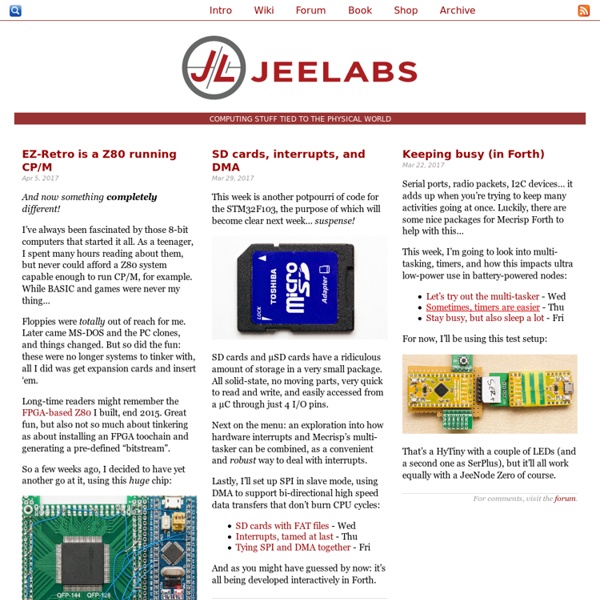



BeagleBoard.org - default sans titre I’ve been working some more on my 8×8 LED matrix clock. I’ve added a DS1307 RTC chip, which has to run from the 5v pin on the NodeMCU and use 10k pullup resistors between 3.3v and the SCL/SDA pins on the NodeMCU and DS1307. I’m using the Adafruit fork of RTCLib as it has better ESP8266 support and uses unixtime. I’m using this chip as I’ve got a load of them and already have a veroboard setup with the coincell and crystal. I’ve also added a button, which when pressed reads the time from the RTC and displays it, then it fetches the NTP time over the internet and updates the display (and RTC). Also a single pixel is lit when the display is showing NTP time, so I can differentiate between RTC and NTP. I’m not sure if I’m going to replace the NodeMCU with just a bare ESP-12E on some breadboard fed by a LiFePO4 battery, or stick with the whole NodeMCU powered from a USB mains adaptor. For the 8×8 LED matrices I’m using my fork of the LedControl library. The code is: Edit: finished video.
AVR Core :: Overview :: OpenCores Details Name: avr_core Created: Nov 5, 2002 Updated: Feb 4, 2014 SVN Updated: Oct 28, 2012 SVN: Browse Latest version: download Statistics: View Other project properties Category: Processor Language: Development status: Stable Additional info: none WishBone Compliant: No License: Description Microcontroller core compatible with one used in AT mega 103 and written in VHDL. Features • Core features: – 32 x 8 general purpose registers – Twenty three interrupt vectors – Supports up to 128 Kb of program and up to 64 Kb of data memory • Peripheral features: – Programmable UART – Two 8-bit Timer/Counters with separate prescalers and PWM – Eight external interrupt sources – Two parallel ports Status The core was tested with several ASM and C programs.
IBM1130.org: All about the IBM 1130 Computing System Contrôler un mini servo avec Arduino Contrôler un mini servo avec Arduino Avec mon pote Idleman, on a pour projet de réaliser un robot (mais chut j’en dis pas plus pour le moment), et qui dit robot dit moteur, articulation, etc… N’ayant jamais piloter de servo moteurs, j’ai décidé d’acheter sur la baie des mini servo de 9g. Fonctionnement d’un servo moteur Tout d’abord, il faut s’avoir qu’un servo permet d’effecter des déplacements en translation ou en rotation. De nombreux objets du quotidien utilisent des servo moteurs: voitures télécommandées, drône, électroménager, … Les différents types de servos se distingue par 3 caractéristiques: leur vitesse de rotation par secondeleur course en degréleur couple exprimé en kg.cm Le fonctionnement d’un servo est relativement simple. Ces impulsion doivent être envoyée de manière périodique, généralement toutes les 50ms. Il n’y a rien de compliquer pour brancher un servo. C’est donc via le fil orange que les commandes seront passées à votre servo. Connecter un servo sur un Arduino
Afghanistan's Amazing DIY Internet The Afghan city of Jalalabad has a high-speed Internet network whose main components are built out of trash found locally. Aid workers, mostly from the United States, are using the provincial city in Afghanistan's far east as a pilot site for a project called FabFi. It's a broadband apart from the covert, subversive "Internet in a suitcase" and stealth broadband networks being sponspored by the U.S., aimed at empowering dissidents, but the goal isn't so different: bringing high-speed onilne access to the world's most remote places. Residents can build a FabFi node out of approximately $60 worth of everyday items such as boards, wires, plastic tubs, and cans that will serve a whole community at once. While it sounds like science fiction, FabFi could have important ramifications for entire swaths of the world that lack conventional broadband. FabFi is an open source project that maintains close ties to MIT's Fab Lab and the university's Center for Bits and Atoms. [Images: Courtesy FabFi]
Sourcing electronic components for synth-DIY "Not discontinued, you understand,just on a 52-week lead time." —Dan Mills Hardware Eurorack frames AKA Eurocard frames AKA IEC 60297 sub-racks. supermoduul.com have them cheap. Connectors 0.145" / 3.68 mm pitch Molex 1625 series. Male pins Molex 02-06-2103 (Digi-Key WM1000-ND, Farnell 1079887) Receptacle for male pins, 3-way Molex 03-06-2032 (Digi-Key WM1221-ND, Farnell 1593638) Receptacle for male pins, 4-way Molex 03-06-2042 (Digi-Key WM1222-ND, RS 679-4855) Switches Keyboard switches RS 664-581 (Cherry MX1A-A1NN) does not include a keycap, contrary to what the photo on the web site suggests. Passives Capacitors Dielectrics Potentiometers The most common types of shaft are : round, 1/4" (6.35 mm) ; round, 6 mm; "knurled" a.k.a "serrated" a.k.a. Curves a.k.a. laws a.k.a. tapers : the three most common curves are linear, log (a.k.a. One of the best deals there is on pots is the Alpha RV160 knurled shaft carbons. Some people prefer G&H or Song-Huei's 16-mm carbon pots. Beware of Piher pots. Anti-log pots
Mat's Hideout | rants, raves, rhymes, reviews